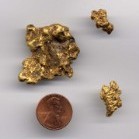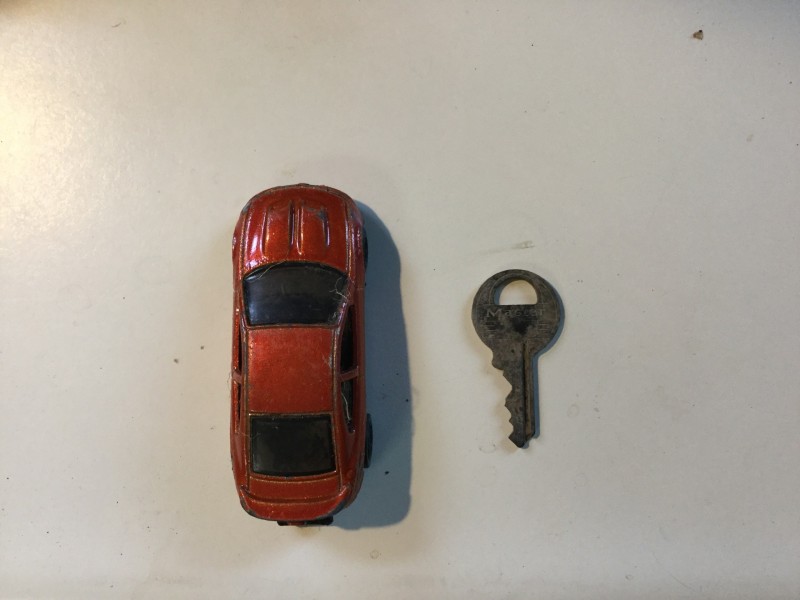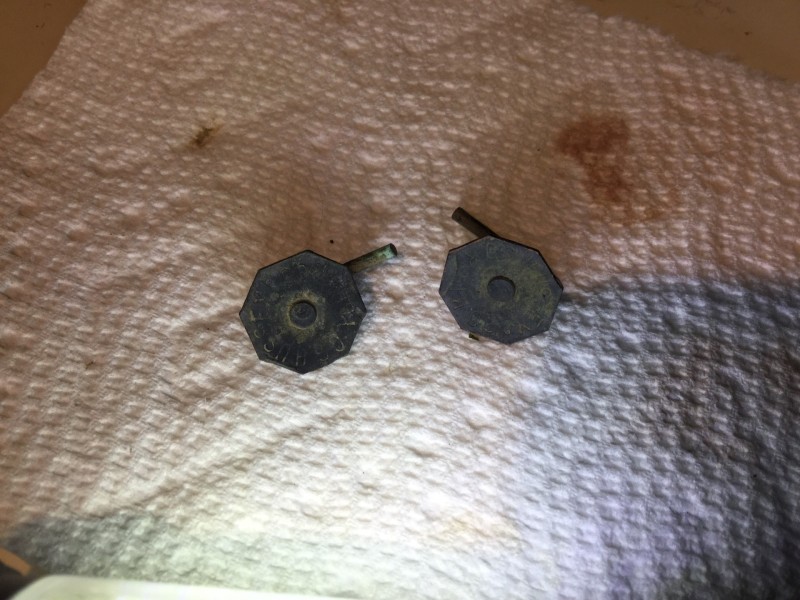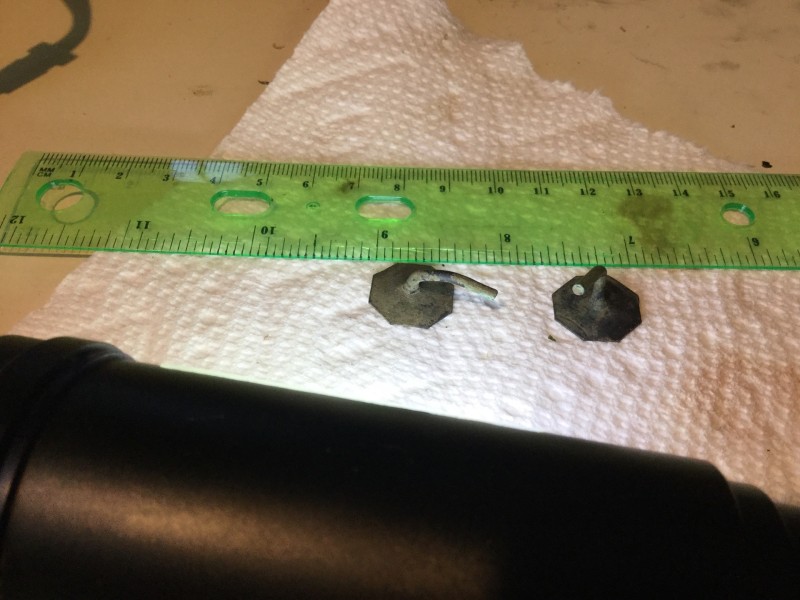-
Posts
339 -
Joined
-
Last visited
Content Type
Forums
Detector Prospector Home
Detector Database
Downloads
Everything posted by Geologyhound
-

Need Help With Button Identification
Geologyhound replied to Doc Bach's topic in Metal Detecting For Coins & Relics
Couldn’t see it that well on the picture. But, I am guessing they are Roman numerals. Could it be an X? If so it would be 16 (XVI). -

Need Help With Button Identification
Geologyhound replied to Doc Bach's topic in Metal Detecting For Coins & Relics
I believe the back says Young Smith & Co New York. They were manufacturing buttons during the Civil War. Looking for more info... -

Help Identifying Rocks From Western Kentucky
Geologyhound replied to TexasNomad82's topic in Rocks, Minerals, Gems & Geology
Sometimes it is difficult to discern the difference between scratching and breaking - especially when you have multiple minerals and/or grains/crystals held together in a semi-open framework or loose cementation. But, with the capability of scratching glass, as Valens Legacy noted, you do have quartz. Google Kentucky geodes. Some of them can be quite pretty inside. You can crack them with a hammer, but I prefer cutting with a rock saw. -

Help Identifying Rocks From Western Kentucky
Geologyhound replied to TexasNomad82's topic in Rocks, Minerals, Gems & Geology
The bedrock in that area is primarily Mississippian age limestone formations with a capping sandstone member all overlaid with Quaternary alluvium. Surficially, your stone has the appearance of a desert rose (selenite or barite). While there are apparently gypsum and anhydrite beds in the St. Louis Limestone which could be the source for selenite crystals, western Kentucky is not the right environment for the formation of desert roses. However, the area around Muldraugh Dome is known for geodes. Quartz geodes up to a third of a foot in diameter are common. The Kentucky Geological Survey does say selenite and barite geodes are possible. So, try to scratch it with your fingernail. If it scratches with your fingernail then it very likely is selenite. If you can’t scratch it with your fingernail but you can scratch it with a copper penny (not zinc so use a penny before 1982) and it feels relatively heavy than it is probably barite. If it won’t scratch with a copper penny, but the stone will scratch glass, then is a quartz geode. -
Maybe it needs a new battery...
-
Look at preamp gain. I generally am only able to bump that by a couple notches before my XLT starts getting very twitchy. You can also look at mixed mode. That will give you the depth of the all metal mode and the discriminatory response of the AC mode when a target is within a depth range which can be discriminated. Otherwise you will hear the DC mode tell you there’s a target and no corresponding tone from the discriminating circuit may mean it is too deep to discriminate. In such instances, definitely check in pinpoint mode to see if the targets are larger than a point source. Also, slow down and overlap your sweeps by at least 50% because the shape of the detected area is a cone which narrows with depth.
-
It even came with a key! Unfortunately even if I can get it to turn on I don’t think I would be able to fit in it... 🤣
-
Do you have any pictures you can post?
-

Is It Time To Move On Beyond Whites Metal Detectors?
Geologyhound replied to Michaeldoc2u's topic in White's Metal Detectors
Well, in my case, I went ahead and got a newer detector (just recently - still learning). But I’m not planning on getting rid of my Spectrum XLT which I’ve had for about 25 years. My kids are old enough they want to go detecting now. So they have been taking out the XLT. I might have to get the screen fixed though, several of the lines are dead. However since the XLT can use regular batteries, the XLT might outlive my new detector’s built-in rechargeable. I also have a sneaking suspicion that the XLT might have an edge over my new detector under certain conditions - a suspicion I will have to put to the test the next time we go back to a couple sites. -
True, but if you’re finding 19 teens from a site which was in use at that time, or a consistency in dates (like 40s and 50s pennies and nickels), then I consider that at least a hopeful indicator that similar period coinage of higher denomination may be present. Hey, a guy’s got to hope doesn’t he? 😁
-

Difference Between Iron False And Co-located Signals?
Geologyhound replied to Geologyhound's topic in XP Deus II Forum
I was also running iron volume four, B caps five, and silencer two, square, pitch. The nails I was catching were in the medium range (around 4 to 6 inches). I have only had my D2 for about a month. Still climbing my way up the learning curve - low gear... I may just have to take one of those nails I recovered, drop it in a hole and stick a coin close to it and see what happens. So far, I have experimented back-and-forth with square versus PWM. Even with nails and can slaw, I can’t discern a difference in tone with PWM from different approach directions. So for now, I’ve been sticking with square pitch trying to build experience and trust. In this situation with sparse iron, would a higher silencer setting help? As I’m running off of a modified fast I don’t think I have access to IAR, do I? I have F350 Platinum’s relic reaper program set up in the neighboring slot, so I suppose I could just switch back to that and maybe tweak the IAR for the day. But, I don’t know how deep a zone that would help before it perhaps became counterproductive. -
If it’s truly flotsam, work your way around the edges closest to the water. Aluminum is lighter and will wash further up…
-
I like wheats too. I take them as a good indicator of the time the site was in use. I keep telling myself if there are wheats, then the other coins (non-nickel…) will be silver. Of course, the only two silver war nickels I found were next to old schools…
-
Thank you all!
-
I was hunting at a site yesterday. Interference from the neighboring cell tower was much better than last week. I was hunting a slightly different area with fewer targets, so I could run my D2 flat out. Modified fast, sensitivity Max, reactivity zero. I hit several good signals – at least for about 2/3 of the swing angles. The other third of the arc gave me iron tones. Every one I dug was a crusty old iron nail, or part of a nail. Note that I was only digging these signals if they were small. The large ones with iron tones with a small good tone on the end I passed over. I checked the holes again after recovering each nail and there was nothing left - not even in pinpoint mode. The MI6 also couldn’t find anything else in the hole or plug. These were not even that deep - generally 6 inches or less. For these small targets, how do you tell the difference between true iron false and a good target co-located with iron?
-

Strange Rock Found While Metal Detecting
Geologyhound replied to The Pest's topic in Rocks, Minerals, Gems & Geology
Againstmywill is on to something here. Ferromanganese is not magnetic (Ferrochrome is magnetic). Ferromanganese typically has a dark crust which your pictures show (Ferrochrome does not). The high density fits. I cannot find any hardness information online. That may be because of the wide range of possible compositions in the Fe-Mn series along with other elements/minerals which may be added at a foundry to achieve specific properties. -
Found two of these today, and one at another site a while back. Every one has the back shaft bent over in a hook shape. These are both stamped C G Hussey & Co PGH PA. I know this company made copper goods including copper rivets. I am guessing they are a copper rivet? If so, anyone know how they were used? Thanks!
-

Rock I Found Yesterday. I Don't Know What It Is.
Geologyhound replied to Ezra's topic in Rocks, Minerals, Gems & Geology
Dolomite is commonly found with the sulfide minerals pyrite and calcopyrite which are easily mistaken for gold. It is not usually associated with gold unless there has been some extensive hydrothermal alteration of the rock and deposition of hydrothermal quartz and iron - say, in association with a skarn deposit. However, the grain size of your rock is too small to be consistent with a skarn deposit, and it does not have any of the typical hallmarks of contact metamorphism. -

Rock I Found Yesterday. I Don't Know What It Is.
Geologyhound replied to Ezra's topic in Rocks, Minerals, Gems & Geology
Did a powdered sample of it fizz with acid? If so then it sounds like dolomite. If not, then your breath test suggests it may be Argillite. If it is Dolomite, market price might be around $50-$60 per ton for a supplier selling the product. That may depend on the purity. However the demand is going to be met by large mines shipping it out by the truckload. For a single boulder, it might be worth something as an ornamental stone if you can find a buyer. But the cost of shipping it would exceed the cost of the stone. -
Gold is gold. That’s a gorgeous looking coin. Are you thinking about grading it?
-

Rock I Found Yesterday. I Don't Know What It Is.
Geologyhound replied to Ezra's topic in Rocks, Minerals, Gems & Geology
The problem with pouring a weak acid on limestone is that the acid runs off and it is difficult to tell whether bubbles formed or you just trapped air bubbles in nooks and crannies of the rock when you poured the fluid over it. Ideally, with a weak acid, you would immerse part of the rock and watch for a few minutes. If bubbles appear where there were no bubbles before, that is a positive result. With a stronger acid, most limestone would just fizz like crazy and there is no mistaking it. Depending on the limestone composition (carbonate versus dolomite versus aragonite), it may not react with acid without some help. For example, dolomite won’t react with acid unless you powder a sample of it first. If you open your mouth and breathe on it (make sure it is dry first ) like you’re trying to fog up glasses, do you get a musty/earthy smell? If so, it could be argillite – a slightly metamorphosed mudstone. That wouldn’t quite fit with the glistening description, and most argillite should be relatively soft. But it’s a thought. Any chance it could be a chunk of Portland cement? Let me know if any of those work out. Beyond that there’s not a whole lot I can do without seeing it in person. However a geology department at a local University, or even a local rock shop, might be able to ID it once they see it in person. -

Rock I Found Yesterday. I Don't Know What It Is.
Geologyhound replied to Ezra's topic in Rocks, Minerals, Gems & Geology
You could try an acid test. Typically, dilute hydrochloric acid would be used to check for calcium carbonate minerals and will result in vigorous fizzing. Lemon juice or vinegar are weaker and will produce bubbles if watched for a period of time. Muriatic acid is a commercially available form of more concentrated hydrochloric acid (with other impurities). If you try muriatic, you may want to dilute some first. Depending on your concentration, a 5 part water to 1 part acid dilution may work. When diluting acid, always add the acid to the water - not the other way around. Drip your acid on the rock and watch for a reaction. With weaker acids, you may want to immerse part of the rock in the acid and see if bubbles form. -

Rock I Found Yesterday. I Don't Know What It Is.
Geologyhound replied to Ezra's topic in Rocks, Minerals, Gems & Geology
Down in that neck of the woods, it would almost certainly have to be a sedimentary rock. You have a lot of sandstones, mudstone etc. Depending on where you found it, there is also the possibility it could be a chunk of limestone washed down river. Since it glistens in the sun, at this point I would guess at sandstone or possibly limestone. If you rub it or scratch at it with a screwdriver, does it shed any grains of sand? Alternatively if you happen to have some dilute hydrochloric acid (0.1 molar), you could drip some on the stone and if it fizzes, it is limestone. -

Rock I Found Yesterday. I Don't Know What It Is.
Geologyhound replied to Ezra's topic in Rocks, Minerals, Gems & Geology
Can you describe the texture of the rock or say where you found it? If you look closely, does it appear to have tiny fossils or crystal surfaces that glisten in the sun? Based solely on the color of the rock and the general fine-grained texture, I would guess at some extrusive igneous rock like rhyolite, or a sedimentary rock like limestone or shale. There are a lot of differences in those rocks. Where you found it and what it looks like up close could help narrow that field (or suggest other possibilities).




